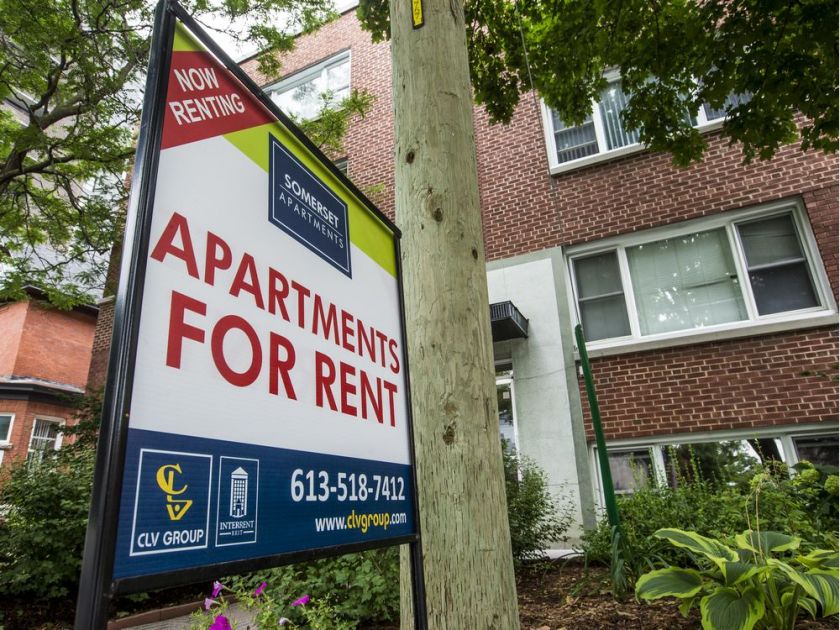Rental properties in downtown Ottawa. August 8, 2018. Errol McGihon/Postmedia
While it might have become a little easier to find a rental in Ottawa in 2019, it also got more expensive to cover the rent, on average.
That’s the big take-away from the Canada Mortgage and Housing Corporation’s 2019 rental market report for the Ontario side of Ottawa-Gatineau, released Wednesday.
While the national vacancy rent for rental apartment units shrank for the third year in a row to 2.2 per cent, the same vacancy rate in Ottawa rose slightly, from 1.6 per cent in 2018 to 1.8 per cent in 2019. It’s the first year since 2015 that the vacancy rate in the capital has eased rather than tightened.
Important to note, however, is that this uptick was driven by an increased bachelor apartment vacancy rate — the movement in vacancy rates for all other bedroom-count units was not statistically significant.
Anne-Marie Shaker, an CMHC analyst, explained that Ottawa was well-past due for new rental apartment construction. “We had an aging purpose-built apartment stock, most of the apartment stock was built in the ’70s and ’80s,” she said.
With new supply coming online, and rental construction slated to continue, “We do expect … that the vacancy rate will go up slightly,” said Shaker. At the same time, “the demands still remain strong for Ottawa, even though we’re seeing rising supply.”
CMHC cites steady net migration to Ottawa as a factor pushing this demand — newcomers tend to rent for their first few years in Canada. So too is “strong employment growth” among the students and young professionals who make up much of the rental market.
Local and international students at Ottawa’s universities and colleges are also “a key force for rental demand” in the city, according to CMHC.
As the appetite for rentals accommodations remains strong, don’t expect bargain basement rents. In 2019 the average rents in Ottawa for bachelor and one-bedroom apartments were $933 and $1,178, respectively, and rose 6.8 and 8.1 per cent between 2018 and 2019.
The capital saw higher rent growth than the country as a whole. While the average rent for a two-bedroom apartment in Ottawa was $1,410 in 2019, and up eight per cent from the year before, the same measure only rose 3.9 per cent nationwide over the same period and the average two-bedroom rent in Canada was $1,077 in 2019.
In addition to healthy demand, Shaker includes new rental construction and low tenant turnover among the reasons for Ottawa’s higher-than-average growth in rents.
“Stricter mortgage rules, low resale supply and rising MLS average prices may have pushed down turnover rates as households chose to continue to rent over transitioning into home ownership,” the CMHC report notes.
Relative to Canada’s largest cities, Ottawa is still pretty affordable.
Compared with $1,410 in the capital, the average rent for two-bedroom apartment in Toronto was $1,562 in 2019. In Vancouver it was $1,748.
But in Calgary and Edmonton, the average was $1,305 and $1,257, respectively.
Quebec, as usual, is in a league of its own. In Montreal, the two-bedroom average was $855 while in Gatineau, it was $874.
Among Ottawa neighbourhoods, the vacancy rate was highest and went up the most in Sandy Hill/Lowertown between 2018 and 2019, rising to 2.7 per cent. The runner-up was downtown, where the vacancy rate rose to 2.6 per cent. Chinatown/Hintonburg wasn’t far behind, with a 2.3 per cent vacancy rate.
Most of the new rental supply in 2019 was in Chinatown/Hintonburg and Sandy Hill/Lowertown, “explaining the upward pressure on the vacancy rate in those zones,” CHMC concludes.
Downtown, the buoyant vacancy rate was thanks in large part to expensive two-bedroom units. The average asking rent across vacant two-bedrooms was 17 per cent higher downtown than the city’s average and at $1,798 was the highest in urban Ottawa — likely leading to a higher vacancy rate for this particular unit type.
A similar phenomenon was seen in west Ottawa, including Kanata, where the average asking rents on vacant two-bedrooms were 62 per cent higher than Ottawa’s average, “likely contributing to an increase in the vacancy rate,” according to CMHC.
ALSO IN THE NEWS
Strike efforts ramp up: Most Ottawa schools closed on Wednesday, more closures to come
Nussbaum leads throw-down on Rideau Canal Skateway in NCC video
